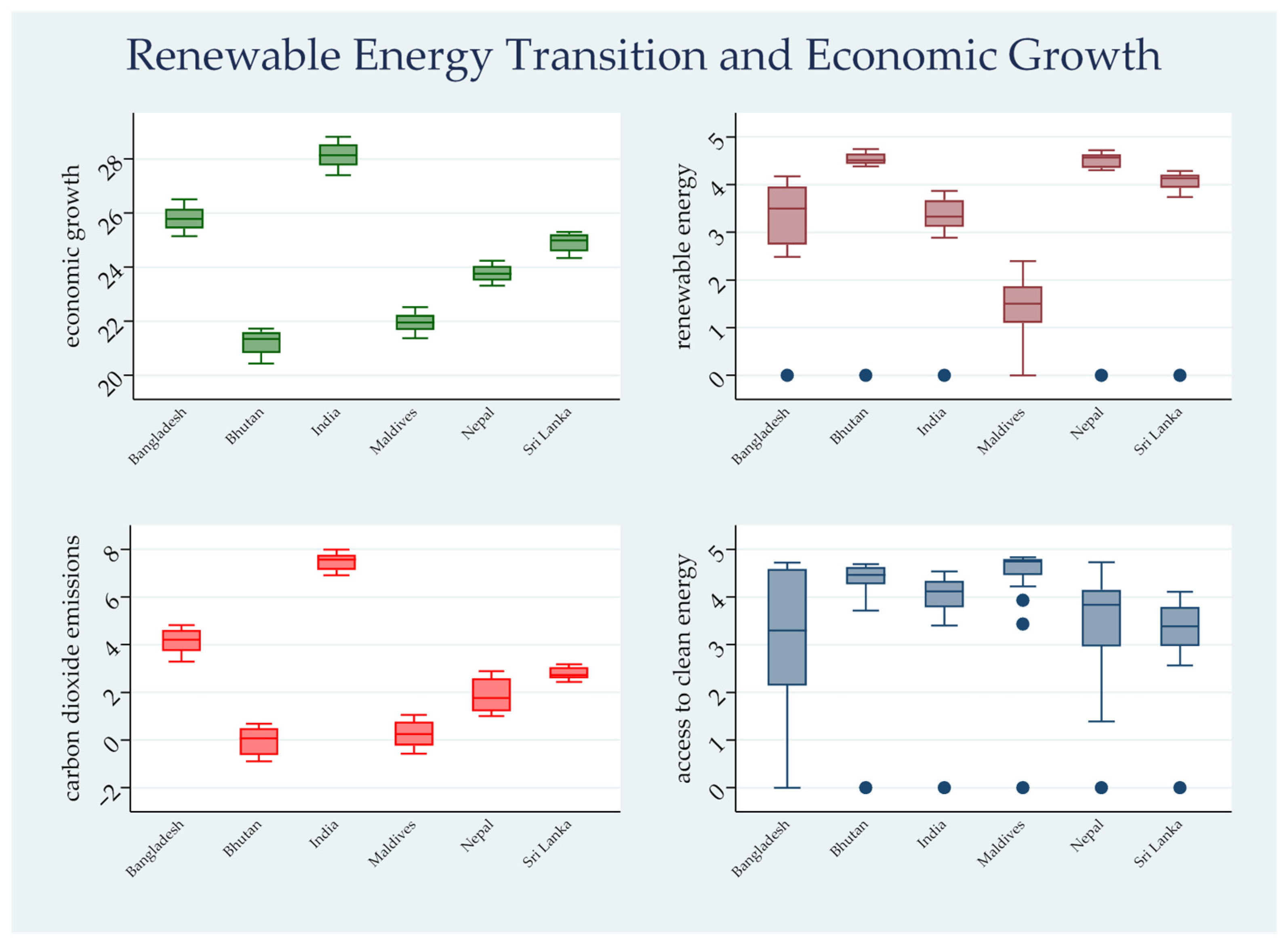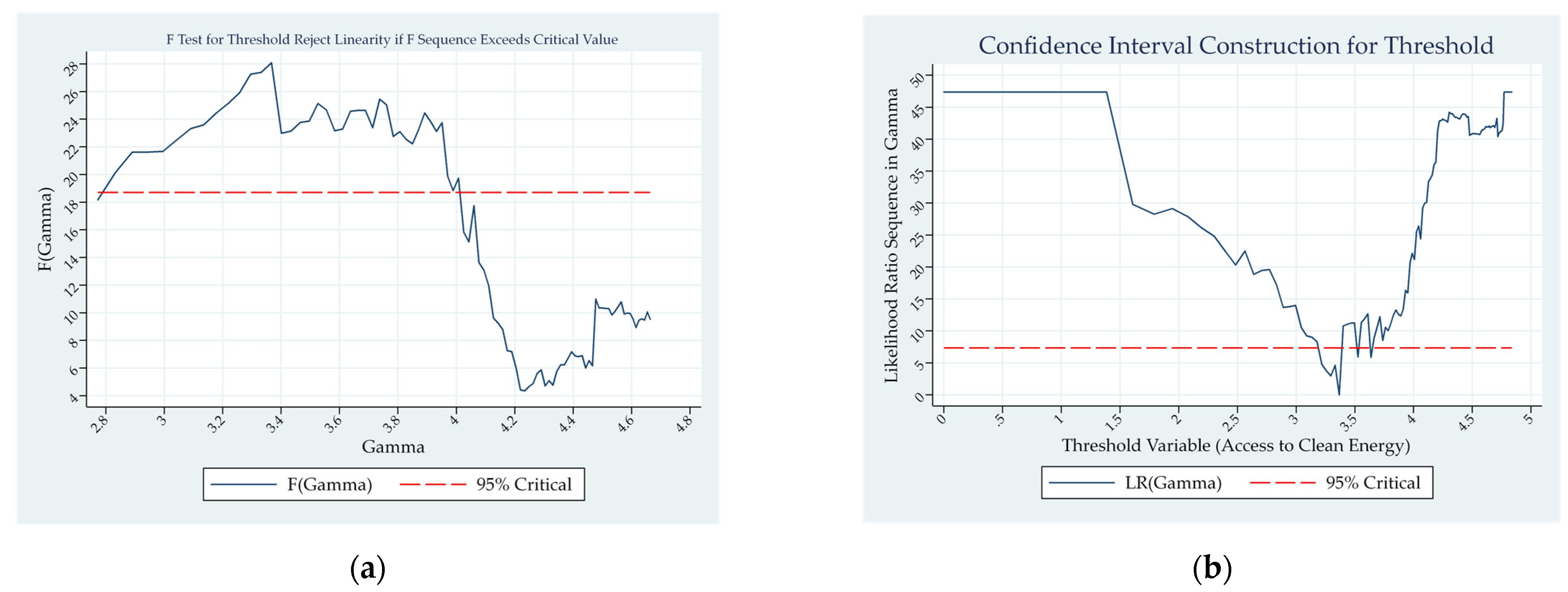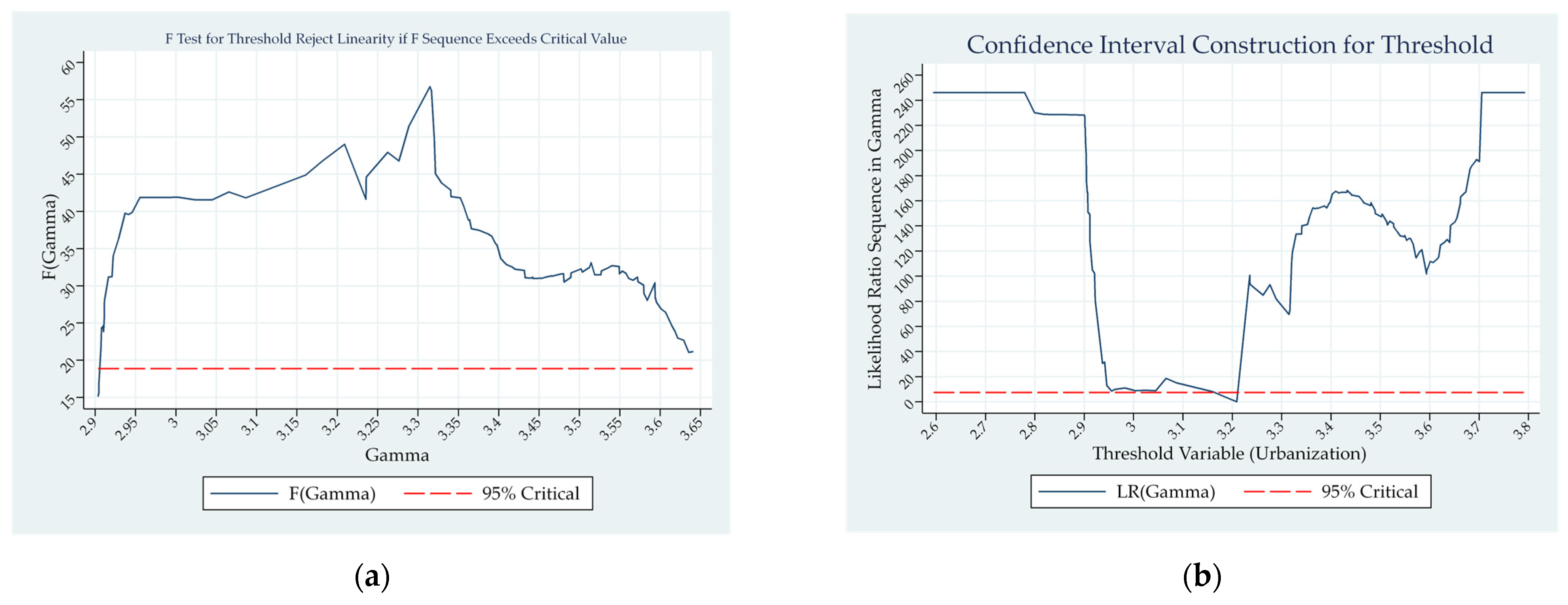Renewable Energy Transition and Sustainable Economic Growth in South Asia: Insights from the CO2 Emissions Policy Threshold
Abstract
1. Introduction
2. Data and Methods
2.1. The Data
2.2. Definition of Variables
2.2.1. Dependent Variable
2.2.2. Independent Variable
2.2.3. Threshold Variable
2.2.4. Control Variable
2.3. Model Specification
3. Results
3.1. Stylized Facts
3.2. Preliminary Data Analysis
Descriptive Statistics
3.3. Benchmark Model: Threshold Effect Tests and Estimations
4. Discussion
5. Conclusions
Author Contributions
Funding
Institutional Review Board Statement
Informed Consent Statement
Data Availability Statement
Conflicts of Interest
Abbreviations
| SDGs | Sustainable Development Goals |
| BRICS | Brazil, Russia, India, China, and South Africa |
| ARDL | Autoregressive distributed lag |
| IEA | International Energy Agency |
| STIRPAT | Stochastic Impacts by Regression on Population, Affluence, and Technology |
Appendix A
| Variables | Symbols | Definition | Source |
|---|---|---|---|
| Economic growth | growth | Annual % growth rate of GDP constant 2015 | WDI |
| Renewable energy consumption | energy | Renewable energy consumption is the share of renewable energy in total final energy consumption. | WDI |
| Access to clean energy | access | Access to clean fuels and technologies for cooking (% of population) | WDI |
| CO2 emissions | emissions | Carbon dioxide (CO2) emissions (total) excluding LULUCF (Mt CO2e) | WDI |
| Urbanization | urban | Urban population (% of people living in urban areas) | |
| Trade openness | trade | Trade (% of GDP) | WDI |
| Foreign direct investment | fdi | Net inflows (% of GDP) | WDI |
| Gross capital formation | gcf | Gross capital formation (% of GDP) | WDI |
| Labor force | labor | Labor force participation rate, total (% of total pop-ulation ages 15–64) | WDI |
References
- Qudrat-Ullah, H. A Review and Analysis of Green Energy and the Environmental Policies in South Asia. Energies 2023, 16, 7486. [Google Scholar] [CrossRef]
- Murshed, M.; Mahmood, H.; Alkhateeb, T.T.Y.; Banerjee, S. Calibrating the impacts of regional trade integration and renewable energy transition on the sustainability of international inbound tourism demand in South Asia. Sustainability 2020, 12, 8341. [Google Scholar] [CrossRef]
- Lal SR, S.; Herbert GM, J.; Arjunan, P.; Suryan, A. Advancements in renewable energy transition in India: A review. Energy Sources Part A Recover. Util. Environ. Eff. 2025, 47, 2024921. [Google Scholar] [CrossRef]
- Cozzi, L.; Martinos, A.; Spencer, T. Global Energy Review 2025. 2025. Available online: https://iea.blob.core.windows.net/assets/5b169aa1-bc88-4c96-b828-aaa50406ba80/GlobalEnergyReview2025.pdf (accessed on 25 August 2025).
- Rana, A.; Gróf, G. Assessment of the Electricity System Transition towards High Share of Renewable Energy Sources in South Asian Countries. Energies 2022, 15, 1139. [Google Scholar] [CrossRef]
- Noor, M.; Khan, D.; Khan, A.; Rasheed, N. The impact of renewable and non-renewable energy on sustainable development in South Asia. Environ. Dev. Sustain. 2024, 26, 14621–14638. [Google Scholar] [CrossRef]
- Zeb, A.; Shuhai, N.; Ullah, O. Navigating sustainability and economic growth: The dual influence of green economic growth and technological innovation on environmental outcomes in South Asia. Environ. Dev. Sustain. 2025, 1–26. [Google Scholar] [CrossRef]
- Miao, Y.; Bukhari, A.A.A.; Bukhari, W.A.A.; Ahmad, S.; Hayat, N. Why fossil fuels stifle green economic growth? An envi-ronmental management perspective in assessing the spatial spillover impact of energy consumption in South Asia. J. Environ. Manag. 2025, 373, 123471. [Google Scholar] [CrossRef]
- Rahman, H.; Voumik, L.C.; Akter, S.; Radulescu, M. New insights from selected South Asian countries on the determinants of GHG emissions. Energy Environ. 2025, 36, 958–978. [Google Scholar] [CrossRef]
- Hassan, M.U.; Siddique, H.M.A.; Sumaira; Alvi, S. Impacts of industrialization, trade openness, renewable energy consumption, and urbanization on the environment in South Asia. Environ. Dev. Sustain. 2025, 1–24. [Google Scholar] [CrossRef]
- Zulfiqar, M.; Fatima, A.; Ullah, M.R.; Huo, W.; Pervaiz, A.; Ghafoor, S. The triple threat: How green technology innovation, green energy production, and financial development impact environmental quality? Nat. Resour. Forum 2025, 49, 160–176. [Google Scholar] [CrossRef]
- Triki, R.; Mahmoud, S.M.; Bahou, Y.; Boudabous, M.M. Assessing Renewable Energy Adoption to Achieve Sustainable De-velopment Goals in Ha’il Region. Sustainability 2025, 17, 6097. [Google Scholar] [CrossRef]
- Raihan, A.; Ridwan, M.; Zimon, G.; Rahman, J.; Tanchangya, T.; Bari, A.M.; Atasoy, F.G.; Chowdhury, A.I.; Akter, R. Dynamic effects of foreign direct investment, globalization, economic growth, and energy consumption on carbon emissions in Mexico: An ARDL approach. Innov. Green Dev. 2025, 4, 100207. [Google Scholar] [CrossRef]
- Wang, Q.; Li, C.; Li, R. How does renewable energy consumption and trade openness affect economic growth and carbon emissions? International evidence of 122 countries. Energy Environ. 2025, 36, 187–211. [Google Scholar] [CrossRef]
- Imran, M.; Alam, S.; Jijian, Z.; Ozturk, I.; Wahab, S.; Doğan, M. From resource curse to green growth: Exploring the role of energy utilization and natural resource abundance in economic development. Nat. Resour. Forum 2025, 49, 2025–2047. [Google Scholar] [CrossRef]
- Chen, S.; Paramaiah, C.; Kumar, P.; Khan, S.; Haomu, Q. Toward sustainable tourism: Insights from green financing and re-newable energy. Energy Strat. Rev. 2025, 57, 101618. [Google Scholar] [CrossRef]
- World Bank. World Development Indicators, WDI, 2025, [Online]. Available online: https://databank.worldbank.org/source/world-development-indicators/Type/TABLE/preview/on%20South%20Asian%20Countries (accessed on 25 August 2025).
- Abdulqadir, I.A. CO2 emissions policy thresholds for renewable energy consumption on economic growth in OPEC member countries. Int. J. Energy Sect. Manag. 2023, 17, 1074–1091. [Google Scholar] [CrossRef]
- Abdulqadir, I.A. Urbanization, renewable energy, and carbon dioxide emissions: A pathway to achieving sustainable devel-opment goals (SDGs) in sub-Saharan Africa. Int. J. Energy Sect. Manag. 2024, 18, 248–270. [Google Scholar] [CrossRef]
- Hansen, B.E. Sample Splitting and Threshold Estimation. Econometrica 2000, 68, 575–603. [Google Scholar] [CrossRef]
- Shi, X.; Shi, D. Impact of Green Finance on Renewable Energy Technology Innovation: Empirical Evidence from China. Sustainability 2025, 17, 2201. [Google Scholar] [CrossRef]
- Abdulqadir, I.A. Growth threshold-effect on renewable energy consumption in major oil-producing countries in sub-Saharan Africa: A dynamic panel threshold regression estimation. Int. J. Energy Sect. Manag. 2021, 15, 496–522. [Google Scholar] [CrossRef]
- Im, K.S.; Pesaran, M.; Shin, Y. Testing for unit roots in heterogeneous panels. J. Econ. 2003, 115, 53–74. [Google Scholar] [CrossRef]
- Almulhim, A.A.; Inuwa, N.; Chaouachi, M.; Samour, A. Testing the Impact of Renewable Energy and Institutional Quality on Consumption-Based CO2 Emissions: Fresh Insights from MMQR Approach. Sustainability 2025, 17, 704. [Google Scholar] [CrossRef]
- He, Y.; Huang, P. Exploring the Forms of the Economic Effects of Renewable Energy Consumption: Evidence from China. Sustainability 2022, 14, 8212. [Google Scholar] [CrossRef]
- Wu, S.; Yang, D.; Xia, F.; Zhang, X.; Huo, J.; Cai, T.; Sun, J. The Effect of Labor Reallocation and Economic Growth in China. Sustainability 2022, 14, 4312. [Google Scholar] [CrossRef]
- Li, B.; Nian, V.; Shi, X.; Li, H.; Boey, A. Perspectives of energy transitions in East and Southeast Asia. WIREs Energy Environ. 2020, 9, e364. [Google Scholar] [CrossRef]
- Olabi, A.; Abdelkareem, M.A. Renewable energy and climate change. Renew. Sustain. Energy Rev. 2022, 158, 112111. [Google Scholar] [CrossRef]
- Guo, S.; Yan, X. Investigation of Industrial Structure Upgrading, Energy Consumption Transition, and Carbon Emissions: Evidence from the Yangtze River Economic Belt in China. Sustainability 2025, 17, 4383. [Google Scholar] [CrossRef]
- Derouez, F.; Ifa, A. Assessing the Sustainability of Southeast Asia’s Energy Transition: A Comparative Analysis. Energies 2025, 18, 287. [Google Scholar] [CrossRef]
- Qi, S.; Li, Y. Threshold Effects of Renewable Energy Consumption on Economic Growth under Energy Transformation. Chinese J. Popul. Resour. Environ. 2017, 15, 312–321. [Google Scholar] [CrossRef]
- Chen, C.; Pinar, M.; Stengos, T. Renewable Energy Consumption and Economic Growth Nexus: Evidence from a Threshold Model. Energy Policy 2020, 139, 111295. [Google Scholar] [CrossRef]




| Variables | Obs | Mean | Std. Dev. | Min | Max | ||||
|---|---|---|---|---|---|---|---|---|---|
| Summary descriptive statistics Panel A | |||||||||
| Economic growth | 144 | 24.293 | 2.368 | 20.438 | 28.815 | ||||
| Renewable energy | 144 | 3.334 | 1.412 | 0 | 4.745 | ||||
| Carbon emissions | 144 | 2.745 | 2.617 | −0.898 | 7.991 | ||||
| Access | 144 | 3.725 | 1.139 | 0 | 4.836 | ||||
| Trade | 144 | 3.380 | 1.553 | 0 | 4.836 | ||||
| FDI | 144 | 3.972 | 0.955 | 0 | 4.963 | ||||
| GCF | 144 | 3.380 | 1.553 | 0 | 4.836 | ||||
| Labor force | 144 | 4.000 | 0.157 | 3.674 | 4.246 | ||||
| Urbanization | 144 | 3.302 | 0.328 | 2.595 | 3.792 | ||||
| Pairwise correlations Panel B | |||||||||
| (1) | (2) | (3) | (4) | (5) | (6) | (7) | (8) | (9) | |
| (1) Economic growth | 1.000 | −0.062 * | 0.983 * | −0.227 * | 0.303 * | 0.177 * | 0.163 * | −0.198 * | −0.094 * |
| (2) Renewable energy | 1.000 | −0.079 * | 0.150 * | 0.346 * | −0.368 * | 0.176 * | −0.087 * | −0.472 * | |
| (3) Carbon emissions | 1.000 | −0.169 * | 0.320 * | 0.206 * | 0.242 * | −0.101 * | 0.038 | ||
| (4) Access | 1.000 | −0.224 * | 0.153 * | −0.042 | 0.141 * | 0.215 * | |||
| (5) Trade | 1.000 | −0.382 * | 0.705 * | −0.103 * | −0.220 * | ||||
| (6) FDI | 1.000 | −0.165 * | 0.311 * | 0.381 * | |||||
| (7) GCF | 1.000 | 0.221 * | 0.202 * | ||||||
| (8) Labor force | 1.000 | 0.706 * | |||||||
| (9) Urbanization | 1.000 | ||||||||
| Title 1 | Statistics | p-Values | Fixed-N Exact Critical Values | Signs |
|---|---|---|---|---|
| Im, Pesaran & Shin (2003) [23] Test | 1% 5% 10% | |||
| Economic growth | 2.5909 | 0.9952 | −2.320 −2.080 −1.950 | level |
| −5.4330 | 0.0000 | −2.320 −2.080 −1.950 | ∆ | |
| Renewable energy | 4.3742 | 1.0000 | −2.320 −2.080 −1.950 | level |
| −4.9934 | 0.0000 | −2.320 −2.080 −1.950 | ∆ | |
| Carbon emissions | 2.0445 | 0.9795 | −2.320 −2.080 −1.950 | level |
| −6.4537 | 0.0000 | −2.320 −2.080 −1.950 | ∆ | |
| Access | −0.3173 | 0.3755 | −2.320 −2.080 −1.950 | level |
| −4.9751 | 0.0000 | −2.940 −2.700 −2.580 | ∆ | |
| Trade | −1.1088 | 0.1338 | −2.320 −2.080 −1.950 | level |
| −5.8633 | 0.0000 | −2.320 −2.080 −1.950 | ∆ | |
| FDI | −3.4550 | 0.0003 | −2.320 −2.080 −1.950 | level |
| −7.3049 | 0.0000 | −2.320 −2.080 −1.950 | ∆ | |
| GCF | −1.6751 | 0.0470 | −2.320 −2.080 −1.950 | level |
| −5.4439 | 0.0000 | −2.320 −2.080 −1.950 | ∆ | |
| Labor force | 2.6363 | 0.9958 | −2.320 −2.080 −1.950 | level |
| −4.2017 | 0.0000 | −2.320 −2.080 −1.950 | ∆ | |
| Urbanization | 1.2139 | 0.8876 | −2.320 −2.080 −1.950 | level |
| −4.3541 | 0.0000 | −2.320 −2.080 −1.950 | ∆ | |
| Threshold Effect Test | CO2 Emissions | Access to Clean Energy | Urbanization |
|---|---|---|---|
| Number of Bootstrap Replications: | 5000 | 5000 | 5000 |
| Trimming Percentage: | 0.15 | 0.15 | 0.15 |
| Threshold Estimate: | 2.376 | 3.367 | 3.214 |
| LM-test for no threshold: | 85.355 | 28.084 | 56.750 |
| Bootstrap p-Value: | 0.017 | 0.0004 | 0.037 |
| Threshold Estimation | CO2 Emissions | Access to Clean Energy | Urbanization | |||
|---|---|---|---|---|---|---|
| Panel A | Panel B | Panel C | ||||
| DV: Sustainable Growth | Regime 1 | Regime 2 | Regime 1 | Regime 2 | Regime 1 | Regime 2 |
| Threshold parameter | 2.38% | 2.38% | 3.37% | 3.37% | 3.21% | 3.21% |
| Intercept | 45.485 *** (0.845) | 7.612 ** (3.000) | 22.781 *** (2.093) | 24.949 *** (0.738) | 12.837 *** (0.897) | 26.816 *** (3.178) |
| Renewable energy | −0.164 *** (0.045) | −0.217 *** (0.091) | 0.062 (0.046) | −0.112 *** (0.029) | −0.096 *** (0.035) | −0.0076 (0.0305) |
| CO2 emissions | --- | --- | 0.963 *** (0.035) | 0.896 *** (0.011) | 0.295 *** (0.050) | 0.893 *** (0.0209) |
| Access to clean energy | 0.0549 (0.056) | −0.286 *** (0.091) | --- | --- | 0.0471 (0.032) | −0.100 ** (0.0329) |
| Urbanization | 0.372 (0.260) | 2.922 *** (0.403) | −0.947 *** (0.278) | −1.283 *** (0.129) | --- | --- |
| FDI | −0.064 * (0.036) | 1.107 *** (0.180) | −0.069 ** (0.047) | 0.001 (0.045) | −0.002 (0.024) | −0.0189 (0.0443) |
| Trade | −0.009 (0.031) | −0.241 ** (0.085) | −0.120 *** (0.036) | −0.028 (0.025) | −0.179 *** (0.021) | −0.038 * (0.0297) |
| GCF | 0.252 *** (0.029) | 0.303 ** (0.102) | 0.072 * (0.040) | −0.036 * (0.022) | 0.159 *** (0.026) | −0.039 (0.0448) |
| Labor force | −6.190 *** (0.391) | 0.990 (0.937) | 0.623 (0.665) | 0.413 * (0.237) | 2.928 *** (0.235) | −1.091 * (0.7861) |
| Degrees of Freedom | 57 | 71 | 28 | 100 | 43 | 85 |
| Observations: | 65 | 79 | 36 | 108 | 51 | 93 |
| R2 | 0.9408 | 0.9930 | 0.9857 | 0.9912 | 0.9502 | 0.9923 |
Disclaimer/Publisher’s Note: The statements, opinions and data contained in all publications are solely those of the individual author(s) and contributor(s) and not of MDPI and/or the editor(s). MDPI and/or the editor(s) disclaim responsibility for any injury to people or property resulting from any ideas, methods, instructions or products referred to in the content. |
© 2025 by the authors. Licensee MDPI, Basel, Switzerland. This article is an open access article distributed under the terms and conditions of the Creative Commons Attribution (CC BY) license (https://creativecommons.org/licenses/by/4.0/).
Share and Cite
Mukhtar, M.; Abdulqadir, I.A.; Abubakar, H.S. Renewable Energy Transition and Sustainable Economic Growth in South Asia: Insights from the CO2 Emissions Policy Threshold. Sustainability 2025, 17, 9289. https://doi.org/10.3390/su17209289
Mukhtar M, Abdulqadir IA, Abubakar HS. Renewable Energy Transition and Sustainable Economic Growth in South Asia: Insights from the CO2 Emissions Policy Threshold. Sustainability. 2025; 17(20):9289. https://doi.org/10.3390/su17209289
Chicago/Turabian StyleMukhtar, Mustapha, Idris Abdullahi Abdulqadir, and Hassan Sani Abubakar. 2025. "Renewable Energy Transition and Sustainable Economic Growth in South Asia: Insights from the CO2 Emissions Policy Threshold" Sustainability 17, no. 20: 9289. https://doi.org/10.3390/su17209289
APA StyleMukhtar, M., Abdulqadir, I. A., & Abubakar, H. S. (2025). Renewable Energy Transition and Sustainable Economic Growth in South Asia: Insights from the CO2 Emissions Policy Threshold. Sustainability, 17(20), 9289. https://doi.org/10.3390/su17209289







